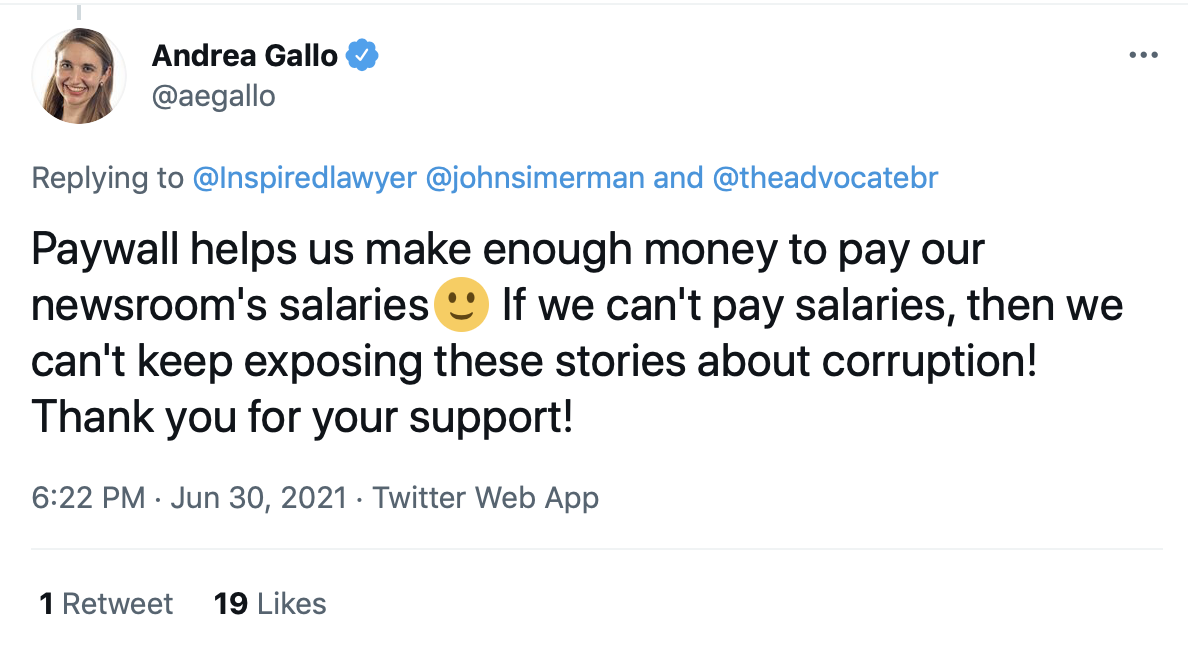If I had one, I'd take down the paywall for this post
/To get background for this blog entry, I wanted to read a particular article about news organizations removing their website paywalls so people could see important COVID-19 stories for free. But it was behind a paywall. I now have a new classroom example of a paradox.
Many major news organizations that require digital subscriptions to view content generated much debate about the wisdom of their making COVID-19 coverage available to anyone who clicked. They cited a vital public service mission of delivering potentially life saving information to their communities. Critics argued that they sacrificed much-needed new revenue that would have helped to pay for continued work on this and other essential topics.
This debate arose again last week when The Athletic, a national sports website, broke a story about sexual assault allegations against a star pitcher for the Los Angeles Dodgers. Some non-subscribers complained on social media that the story was too important to stay behind the site’s paywall. The Athletic subsequently produced a free version of its story.
Many news consumers expect that they shouldn’t have to pay, a result of the many years that news outlets did publish all their work online with free access. Many outlets still do. Joy Mayer, founder of Trusting News, a journalism training program, said in March that readers were getting angry when they came across COVID stories that required subscriber status. A search of Twitter showed examples of posters demanding free access to an array of stuff: profiles of victims of the Surfside building collapse; video of the Capitol riot; an investigative story into misconduct by a state Supreme Court justice; a commentary on Tucker Carlson; and even a feature on the closing of a long-time professional hockey arena.
This, of course, raises the slippery slope question of what kind of content might be vital enough to citizens to warrant dropping the subscription requirement. One common guideline is whether a subject affects health or safety in an urgent manner. For instance, in addition to the pandemic, newsrooms have often waived payment for news about local natural disasters. But many topics are vital. Doesn’t everyone need to see news about social justice or the heinous acts of politicians, to name just two?
The basic concept of ever giving away your marquee work when you increasingly depend on reader revenue in the face of disappearing advertising seems counterintuitive. That’s especially so considering that website traffic (and the chance to sell new subscriptions) skyrocketed during the pandemic. Imagine Dreamland announcing you have to pay for side items but the ribs are free.
A self-interested counterargument – in case helping people isn’t enough reason – is that opening up special coverage creates community good will and showcases quality work, which eventually translates into new subscribers and elevated reputation. I’ve made that argument in support of various ideal practices of journalism. And that happened in some cases in 2020, though the reason may have been the remarkable crush of major news and not related to unblocked access.
More recent evidence is disheartening. According to the international Digital News Report 2021 published last month by the Reuters Institute, the number of Americans extremely interested in news (the most likely to buy a digital subscription) went down 11% from February 2020 to February 2021. That means loyalty created by great and accessible coronavirus coverage in 2020 might have mitigated but couldn’t offset the loss of interest caused by less worry over the pandemic and the departure of Donald Trump. (Good will effects were more pronounced in other countries.) Further, Reuters surveys showed trust in news remained flat in the U.S., “highlight(ing) the challenges of translating 2020’s surging news usage into long-term trust building in the highly polarized American market.”
In an April 2020 commentary criticizing removal of paywalls for coronavirus stories, Howard Saltz of Florida International University and former editor of the South Florida Sun Sentinel wrote that there was “little loyalty” from readers after the Sun Sentinel re-imposed its paywall on previously free stories about Florida hurricanes.
Only 21% of Americans pay for online news, according to Reuters. Other research puts the number lower than that. Subscription decisions are about willingness but also about ability to pay. Putting any content behind a paywall skews access and therefore knowledge toward the affluent. And if that content relates to health or safety in a crisis, the ethical concerns become substantial – and certainly more substantial than the business imperatives.
Funny thing about the different kinds of journalism stories: Vital public service reporting costs the most, carries the most value, and most deserves financial reward. Yet it also warrants the freest and widest distribution. I think I now have an even better example of a paradox.



